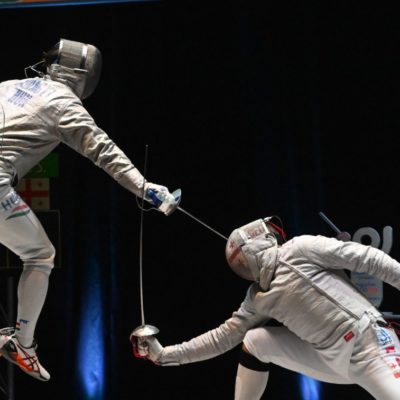{mosimage}Marching attacks are devastating — but they don’t need to be. Part 3 of the Ides of March gives pointers for defeating the march. Zen and caffine. Neither calmness nor wild energy will beat a march, by themselves. The defender must find the right mixture.
(This is the final article in a three-part series on the Foil Marching Attack. Click here for part one, with demonstration video.)
Marches are methodical and constructed, and they work because they cause the defender to crumble under pressure. The best responses to a march, therefore, are to pick apart the construction, and stay calm. For this, the defender needs to find the proper mix of frantic adrenaline and icy calm. Find the weaknesses in the march. Is it too fast? Fake into it. Is it too slow? Use the time to put together a blade solution. Is the attacker using Decision Point? Exhaust them with false decisions. Did the attacker forget Decision Point? Close distance with surprise. Meanwhile, use tactics that will hamper marchers. Counter-attack as they begin, duck when they take a step forward. Tip your hand early to make them over-cautious. |
The first task of the defender is to maintain composure. Marches take a long time (comparatively) to develop, and so there’s nothing surprising about them. With enough strip behind them, defenders have time to see the attack, say, “This is a marching attack,” and then formulate some sort of reaction, all while running away. Marching attacks are effective because they apply pressure to the defender, so if the defender is not feeling pressured, their core strength is nullified. What might have seemed like an impregnable, shrinking net of threat is revealed as an opponent stepping forward waving the blade with a bent arm.
Marching attacks are also effective because they often draw a sucker attack out of the defender. But if the defender is wise, they won’t be suckered. Or, they will pretend to be suckered, and then sucker the attacker with a counter-attack in time, e.g., a second-intention counter-attack. (Depending on your frame of reference, this could be called a second-intention attack on preparation, but it proves quite safe for the defender to perceive the preparations of the march as an actual attack.)
Furthermore, marching attacks suffer from several weaknesses related to their footwork.
Slow marches make for controlled distance, but less-safe bladework. The defender will find it difficult to tease apart the attacker’s footwork, but they have many chances to find the blade.
Fast marches make for safer bladework, but less-controlled distance. The defender will only get a few chances on the blade, but their tempo-breaking footwork will seem very real to the rushing attacker. The defender can appel, do body feints, backwards checks, and have a good chance at fooling the attacker into stopping or pausing their march.
In terms of rhythm — if the attacker (inexperienced, or tired) isn’t using the decision point to gauge their safety, the defender can be quite effective at stealing tempo with a direct attack at the right moment.
If the attacker is using decision point, then the defender can take advantage of the attacker’s caution. They can feign an attack on the preparation, or do a body feint — this will cause the attacker to pause, or at least slow their footwork (they think they’re about to finish). Then the defender can retreat quickly out of distance, and set up an advance lunge of their own. The marching fencer will have to defend, ending their march, or else cede Right of Way in the action (mileage may vary, depending on the director). This is the "getawaygo" made famous by Bucky Leach.
If the marching fencer finishes, then both fencers have their lights on for a possible simultaneous action. Even this is beneficial to the defender. The worst case scenario — the marcher is awarded the touch — is the same outcome the defender would have suffered if they’d done nothing at all.
If the attacker is making the error of crossing their feet during the march, the defender can close their eyes and lunge without a care in the world. Crossovers are explicitly mentioned in the rules as preparations, and nothing the hand is doing can make them into an attack (t.56.a.8).
Lastly, because many fencers finish the march with a flick, the defender can also use all the weaknesses of the flick as part of their defense.
Responses to a developed march
Against a marching opponent, fencers can mix up four simple responses.
- Give distance and beat the blade — Fade back while waiting for something better or searching for blade contact
- Attack on the preparation — Direct lunge, lunge with feint disengage, beat attack
- Point in line — Pull some distance, put the arm out, and derobe around attacks on the blade
- Duck with counter-attack — Treat the march as an attack, and counter into it
With aggravating regularity, the opponent’s attacks will still land, and will still be rewarded by directors. After all, if marches weren’t good for hitting, then fencers wouldn’t use them. But these responses to the march aren’t necessarily for answering the current attack. They are for the next attack, and the attack after that.
The defender’s unpredictability, mixed with the degraded toolset available to the marching opponent, will eventually combine to make marching opponents over-cautious or self-doubting. If nothing else, the opponent will have to be more halting and careful. Net result: Long before the end of the bout, the attacker’s marches are compromised.
Mostly, don’t let marches develop
A promising and growing body of anti-march tactics revolves around closing down the march before it can begin. Given that a good march from a good fencer is hard to break apart, the safest bet is to not let them develop. Marches require early cooperation from the defender — first one step back, then another, then more and more.
Watch Golubitsky’s World Championships finals with Gregory in 1998, and Zennaro in the 1999 — note how every preparation from his opponent is met by an extending arm or suddenly compressed distance. Nothing makes an attacking fencer more uneasy than a swift and decisive answer after the first step… after all, the attacker has just started a forward stroll, and they’re making big blade movements. A tip pointed at the sternum will settle them down very quickly. These are "throwaway" Points in Line, they are not really intended to hit with. They are more like a picket line, a buffer which absorbs the opponent’s inertia and pushes them off. When using throwaway lines, your feet must be highly mobile and able to move you quickly away from threat — do not root.
You can also use the four main responses to the march (above), but use them before the march happens. Best results will be achieved if you show your action just as the opponent begins theirs. The goal isn’t to score a touch, but to show them you’re unpredictable — they will pause and regroup. You can stop many attacks during their early preparation phase, just by faking into them.
Finally, the opponent can’t march if you’re marching first. Start your march before they do, and reap all the benefits (and dangers) of the action. The opponent will probably begin marching even earlier… and before long you will both be going simultaneous. This drops the bout back into non-marching tactics, as each fencer starts flipping through the standard tactical options.





